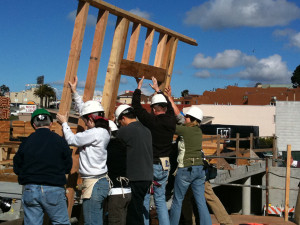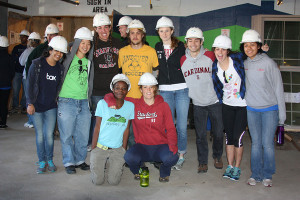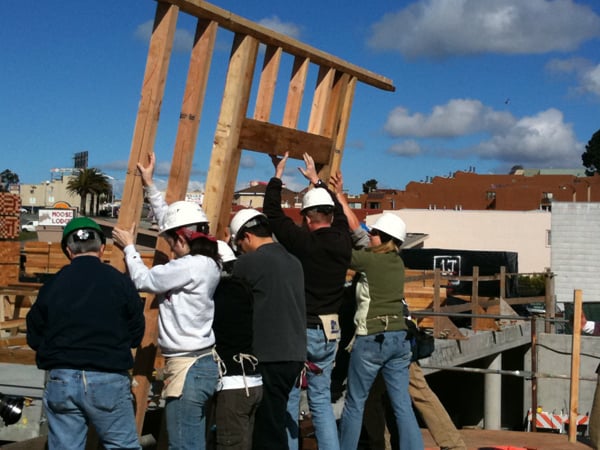The day began at 7:15 a.m., when I grudgingly got out of my bed and threw on the crummiest clothes I could find. I met the rest of the volunteers for the March 3 Habitat for Humanity Build outside of Tresidder Union. Our tired faces lit up when we saw the bag of bagels that was provided for us — the day seemed to be off to a good start.
The Daly City project we would work on that day was the largest ever for Habitat for Humanity Greater San Francisco. The final result would be a four-story condominium development projected to house 36 families.
We reached the construction site at around 8:30 a.m. There were males and females of all ages and ethnicities lined up in front of the toolshed to sign waivers. Of course, by the time it was my turn, they had run out of waivers. I remembered what Keren Mikva ’12, co-president of Stanford’s Habitat for Humanity chapter, had said about the number of volunteers today being “unheard of.”

I stood awkwardly in my oversized construction hat and mismatched pair of gloves, shivering in the morning breeze and unsure of what to do next, until Dawn Adams, the charismatic construction manager on the site, asked for everyone’s attention. Her eyes twinkled from behind circular glasses and her bright red hair was tied into playful pigtails, but her energetic voice was firm and no-nonsense. She talked briefly about Habitat’s general mission and the manner in which the organization operates.
Families that qualify for Habitat typically make 40 to 60 percent of the area’s median income and often live in very crowded spaces or spend exorbitant portions of their income on housing expenses, she said. Habitat keeps homes affordable by implementing zero-interest mortgage payments and calculating the duration of the mortgage based on how much each family can afford to pay. For their part, families must commit to an initial down payment of 500 hours of “sweat equity,” meaning that they physically work on Habitat’s project alongside volunteers.
“I think that’s probably the coolest part of the program,” Mikva said. “Their slogan is a ‘hand-up,’ not a ‘hand-out.’”
Dawn concluded her talk by emphasizing how integral volunteers are to Habitat’s projects.
“Ninety percent of the work done in building Habitat homes is done by volunteers like you guys,” she said. “There’s no carpenters waiting in the wings to come finish things off. We want to acknowledge and appreciate that.”
Next, Ryan Poling, a Habitat employee from Atlanta, Ga., gave us a safety briefing.
“The first thing that we say about safety out here is that safety is a personal concern,” he said. “This is an active construction site; things are changing all the time. You all need to be looking out for yourselves.”
After he had finished, it was time for us to choose a crew to join.

As I was considering which crew I wanted to be on, I thought about what Frank Guzman ’14, the Stanford Habitat chapter’s education and advocacy coordinator, had said to me earlier:
“I think it’s really nice that the level of physical fitness for anyone who goes on one of these builds doesn’t matter,” he said. “There are crews that do a lot of light work that anyone can do, and then there are crews that require you not to be afraid of heights or to do some heavy lifting.”
Not trusting myself in any situation that would involve hammers, nails or heavy objects, I appreciated the variety of options offered. I decided to go with the interior painting crew — of which Poling was the team leader — along with around five other volunteers from Stanford. One of these volunteers was Sean Scott ’15, who will be the build coordinator for Stanford’s chapter next year. Scott was driven to get involved with Habitat because of its physical aspect.
“I like building things,” he said. “I like physical work.”
Poling showed us the different tools we would need and explained the cutting, scraping and rolling techniques that we would use. As we began to paint, I realized it was harder than it seemed. First, cutting is painfully boring. Second, those long, wooden roller extensions may look like fun, but my neighbor whom I nearly whacked in the face twice may not agree. On top of that, every time I tilted my head back to get a better look at the ceiling, my helmet and goggles — which I wore over my glasses — slid back, and I would have to adjust them with my paint-smeared gloves. By noon, when we had lunch break, I had somehow managed to get more paint on my clothes, my hair and my shoes than everyone else combined — and quite possibly, more than on the wall. I must admit though, I felt a strange sense of pride and satisfaction as I walked into the Subway across the street splattered in white paint.
After lunch, I talked to Poling about his experience with Habitat.
“What I like most about the dynamic of Habitat is that you get to work side by side with the beneficiaries of your work,” he said. “You get a really nice, close connection.”
He also discussed how Habitat’s project goes beyond just empowering individual families and relates to larger social issues.
“One of the ways we’ve been dealing with the foreclosure crisis is buying abandoned homes from banks and then fixing them,” Poling said. “That puts our families in homes and improves entire neighborhoods.”
Poling has been working with Habitat for Humanity through AmeriCorps for a year and a half. He has a degree in construction and management.
By 3 p.m., around an hour before we called it a day, three other Stanford students and I had finished painting just one room in one condominium. Thinking about how long it took us to complete the task in light of all the other rooms that still needed to be painted was overwhelming. And that was only one small part of all the tasks waiting to be completed. For the first time, I got an idea of how much can be accomplished in two years, mostly because of inexperienced volunteers like me.
“I looked back at what we did, and I felt a sense of pride because I could see my volunteering efforts,” Guzman had said earlier. “They were tangible.”
I felt the same way.
